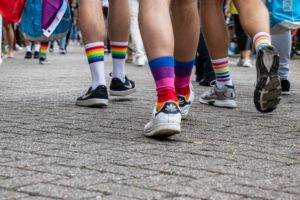Goals

Brief description of the issue
The world of sport and physical activity is strongly stereotypical and divided in function of gender. It is also a place where a lot of gender stereotypes are reproduced: “running/throwing/playing like a girl”, positive reinforcement of boys, link between masculinity and sport, etc. For students who are moving away from the stereotypes associated with their gender, physical education classes can be a place of bullying which is, most of the time, homophobic bullying. It is therefore very important to make sure we create a safe space for all children where they can liberate their potential in sport and physical activity, no matter what their gender is, through hands-on activities like this one.
The Teaching Tolerance website has put together a variety of classroom resources in many social justice domains and on multiple topics. The mission of this organization is “to help teachers and schools educate children and youth to be active participants in a diverse democracy” by providing them free resources. The Gender Bias and Homophobia in Sports activity discusses common characteristics and stereotypes that are associated with athletes. It has been adapted for the needs of this project, but you can find the original activity here.
Essential Questions
- What characteristics do you associate with athletes? Which are positive and which are negative for male athletes? Which are positive and which are negative for female athletes?
- How do gender stereotypes, racism and homophobia affect students?
- What can you do at your school to change homophobic attitudes?
Articles to learn more about the subject:
- Hockey culture promotes homophobic language despite progressive attitude: study
- Homophobia in hockey is real – regardless of the Morgan Rielly verdict
- ‘I don’t want racism in the sport I love’
Vocabulary:
homophobia [ˌhōməˈfōbēə ] (noun) The irrational fear or antipathy toward LGBT people and homosexuality.
stereotypes [ ˈsterēəˌtīp; ˈsti(ə)r- ] (noun) A set of preconceived ideas or beliefs, usually negative, over-generalized to all or most members of a group based on their membership in that group. Stereotypes can be based on race or ethnicity, gender, sexual orientation, age, ability, physical appearance, class or socioeconomic status, occupation, etc.
Procedure:
1. Show some pictures of athletes:
-
- Brigitte Lacquette (first First Nations hockey player to be named to Canada’s National Women’s Team)
- Jesse Cockney (Inuvialuit)
- Spencer O’Brien (Kwakwaka’wakw First Nation)
- Carey Price (Ulkatcho First Nation)
2. Ask students: what words do you think of when you see the pictures? What words would you use to describe the athletes? Write the words down on a chart that looks like this:
Words to describe athletes | Girsl/Women | Boys/Men
3. Lead students in a discussion: Look at the first word on the list. Do you think it is a good quality for a boy or man to have? If so, have a volunteer put a check mark in the column that’s called “Boys/Men.” Do you think it is a good quality for a girl or woman to have? If so, have a volunteer put a check mark in the column that’s called “Girls/Women.” Be careful that all students, boys and girls equally, get the chance to express themselves. You can make sure you do it either by alternating boy/girl when giving the opportunity to students to speak or by picking a name.
4. Have a volunteer read aloud the words that your class thinks are good qualities for men. Have another volunteer read aloud the words that your class thinks are good qualities for women. Are any of the “positive” words the same for both men and women? Which ones? Which words are different? Why do you think that they are different?
5. A stereotype is an assumption made about an individual based on group membership. Look at the chart again. Which of the words on the chart are stereotypes about men and women, about First Nations people, and about athletes? How can you tell that they’re stereotypes? As a class, talk about how stereotypes can devalue and hurt people.
6. Try rethinking the stereotypes identified on the chart. On the Internet, tell students to find pictures of male and female athletes who have the all or most of the traits your class identified. Ask students to make a collage (either with printed picture or with a software) with the pictures. They can write the words from your class’s list on cards or pieces of paper. They should include them in the collage.
7. Share the collages. As a class, discuss what you learned about stereotypes of men and women as well as First Nations athletes. Students can also answer these questions in a journal.
- Do I have stereotypical ideas about gender and sports?
- What can we at our school do develop more positive relationships that dispel stereotypes and misinformation about sports and gender?
- How might knowing what I know now affect what I say to people or things that I do?
- What have I learned? What would I like to know more about this topic?
References
Indigenous Corporate Training. (2020). Celebrate 21 Indigenous Athletes for National Indigenous Peoples Day. https://www.ictinc.ca/blog/celebrate-21-indigenous-athletes-for-national-indigenous-peoples-day
Johnston, S. (2019, June 21). Team Canada celebrates National Indigenous Peoples Day, Team Canada. https://olympic.ca/2019/06/21/team-canada-celebrates-indigenous-day/
